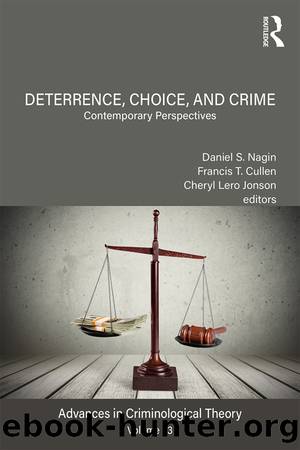Deterrence, Choice, and Crime, Volume 23 by unknow

Author:unknow
Language: eng
Format: epub
Tags: Nonfiction, Social & Cultural Studies, Social Science, Crimes & Criminals, Criminology
ISBN: 9781351112697
Publisher: Taylor and Francis
Published: 2018-04-17T04:00:00+00:00
8
Individual Difference and Deterrence
Thomas A. Loughran, Raymond Paternoster, and Alex R. Piquero
Since its classical origins dating back to Bentham and Beccaria and more contemporary grounding in Beckerâs (1968) work on rational choice, the evolution of the study of deterrence has experienced several important inflection points which have helped to shape how scholars view the role of sanctions in deterring criminal behavior. For instance, Sellinâs (1967) early work on the deterrent effect of the death penalty challenged the traditional rational choice belief (held by many policymakers) that more severe sanctions will always reduce crime. Soon after, Chiricos and Waldo (1970), who refined their analysis by type of crime and considered the effect of lagged changes in the certainty and severity of punishment on crime rates, reached a similar conclusion. Geerken and Gove (1975) argued that macro-level studies of deterrence are perhaps susceptible to the ecological fallacy and thus should be based on individual- level studies on behavior. More importantly, they argued that deterrence at its core is a social psychological theory of individual perceptions of sanction threats, or as Beccaria (1764 [1986]: 75, emphasis added) similarly noted, âSee to it that men fear the laws and only the law.â Based upon the restatement of deterrence theory by Geerken and Gove and initial empirical success by Waldo and Chiricos (1972), focus shifted from the role of objective risks and costs of crime to individualsâ subjective beliefs about these quantities, which can differ across people by everything from crime type, skill, and experience to how informed an individual is. Accordingly, this gave rise to a focus on the study of perceptual deterrence, motivated by the idea that deterrence depends on perceptions of risk and cost (Paternoster 1987; Williams and Hawkins 1986). Again, however, much of this literature has been aimed at discovering a global linkage between risks and costsâeither objective or subjectiveâand subsequent offending behavior, and it has produced only modest associations (Nagin 2013), leaving the question of whether or not sanctions âworkâ as deterrents open to debate.
Most recently, however, a review article by Piquero, Paternoster, Pogarsky, and Loughran (2011) argued for yet another refinement of the question regarding the deterrent effect of sanctions. The authors argue that the key question is not whether sanctions deter, it is assumed that they do to some degree, but instead: (a) under what conditions do sanctions deter? (b) for which kind of persons? and (c) when and for whom do they make things worse or are simply irrelevant? In other words, the deterrent effect of sanctions may be heterogeneous across both situations and persons (and potentially even crime types). Specifically, Piquero et al. (2011) focused on what they describe as the âkinds-of-people dimensionâ of deterrence, which revolves around individual differences in a range of areas, including social bonding, morality, impulsivity and time preference, social network position, and decision-making ability.
This article builds on the concept on individual differences in deterrence theory in several important ways. First, we review some recent advancements on this topic in the key areas identified by the Piquero et al.
Download
This site does not store any files on its server. We only index and link to content provided by other sites. Please contact the content providers to delete copyright contents if any and email us, we'll remove relevant links or contents immediately.
The 1921 Tulsa Race Massacre by Chris M. Messer(283)
Introduction to Criminal Justice - A Balanced Approach by Brian K. Payne Willard M. Oliver Nancy E. Marion(251)
Punishing the Poor The Neoliberal Government of Social Insecurity by Unknown(246)
Russia's Sakhalin Penal Colony, 1849â1917 by Andrew A. Gentes(244)
The History of Newgate Prison by Jowett Caroline;(234)
Serial Killers America and UK - 2 BOOKS IN 1 by Clark Matthew(209)
A History of Police and Masculinities, 1700-2010 by David G. Barrie Susan Broomhall(195)
Restorative Justice in Transitional Settings by Kerry Clamp(167)
Organized Crime and Corruption Across Borders by T. Wing Lo Dina Siegel Sharon I Kwok(158)
Culture, Crime and Punishment by Ronald Kramer(155)
Cops, Cameras, and Crisis by Michael D. White Aili Malm(152)
Dangerousness, Risk and the Governance of Serious Sexual and Violent Offenders by Karen Harrison(152)
Policing Gender, Class And Family In Britain, 1800-1945 by Linda Mahood(151)
Routledge Handbook on Immigration and Crime by Holly Ventura Miller Anthony Peguero(150)
The Real CSI by Kate Bendelow(148)
Women Exiting Prison by Bree Carlton Marie Segrave(140)
Losing Legitimacy by Gary Lafree(137)
Using Murder by Philip Jenkins(135)
A Theory of African American Offending by James D. Unnever Shaun L. Gabbidon(134)
